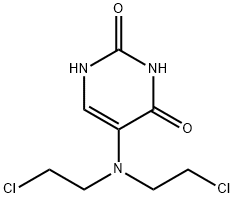URACIL MUSTARD

- CAS No.
- 66-75-1
- Chemical Name:
- URACIL MUSTARD
- Synonyms
- U-8344;CB-4835;ent50439;Nordopan;SK-19849;NSC-34462;Uramustin;ENT 50439;NCI-C04820;Uracillost
- CBNumber:
- CB3500556
- Molecular Formula:
- C8H11Cl2N3O2
- Molecular Weight:
- 252.1
- MOL File:
- 66-75-1.mol
- Modify Date:
- 2024/12/18 14:08:52
| Melting point | 206°C (rough estimate) |
|---|---|
| Density | 1.6350 (rough estimate) |
| refractive index | 1.6100 (estimate) |
| solubility | DMSO (Sparingly), Methanol (Slightly, Heated) |
| form | Solid |
| pka | 9.42±0.10(Predicted) |
| color | Crystals from MeOH (aq) |
| IARC | 2B (Vol. 9, Sup 7) 1987 |
| EPA Substance Registry System | Uracil mustard (66-75-1) |
SAFETY
Risk and Safety Statements
| Symbol(GHS) |    GHS08,GHS05,GHS06 |
|---|---|
| Signal word | Danger |
| Hazard statements | H315-H300-H351-H318-H335 |
| Precautionary statements | P201-P202-P281-P308+P313-P405-P501-P264-P270-P301+P310-P321-P330-P405-P501-P280-P305+P351+P338-P310-P264-P280-P302+P352-P321-P332+P313-P362 |
| RIDADR | 3249 |
| HazardClass | 6.1(a) |
| PackingGroup | I |
| Hazardous Substances Data | 66-75-1(Hazardous Substances Data) |
| Toxicity | LD50 i.p. in rats: ~1.25-2.5 mg/kg (Chaube, Murphy) |
URACIL MUSTARD Chemical Properties,Uses,Production
Description
Uracil mustard appears as creamy/off-white, odourless, crystalline powder. It is used as an anti-cancer medicine. Uracil mustard is a chemotherapy drug that belongs to the class of alkylating agents. It is used for its anti-neoplastic properties. It works by damaging deoxyribonucleic acid (DNA), primarily in cancer cells that preferentially take up the uracil due to their need to make nucleic acids during their rapid cycles of cell division. At high concentrations of the drug, cellular RNA and protein synthesis are also suppressed. The DNA damage leads to apoptosis of the affected cells. Chemically it is a derivative of nitrogen mustard and uracil. Uracil mustard is a non-combustible substance itself; it does not burn but may decompose upon heating to produce corrosive and/or toxic fumes. Some are oxidisers and may ignite combustibles – wood, paper, oil, clothing, etc. Contact with metals may evolve flammable hydrogen gas. Containers may explode when heated.
Uses
Antineoplastic.
General Description
Creamy white crystals or off-white powder. Used as an anti-cancer medicine.
Air & Water Reactions
Slightly soluble in water [Merck].
Reactivity Profile
URACIL MUSTARD (500 MG) (FOR U.S. SALE ONLY) reacts as a base.
Health Hazard
TOXIC; inhalation, ingestion or skin contact with material may cause severe injury or death. Contact with molten substance may cause severe burns to skin and eyes. Avoid any skin contact. Effects of contact or inhalation may be delayed. Fire may produce irritating, corrosive and/or toxic gases. Runoff from fire control or dilution water may be corrosive and/or toxic and cause pollution.
Fire Hazard
Non-combustible, substance itself does not burn but may decompose upon heating to produce corrosive and/or toxic fumes. Some are oxidizers and may ignite combustibles (wood, paper, oil, clothing, etc.). Contact with metals may evolve flammable hydrogen gas. Containers may explode when heated.
Safety Profile
Suspected carcinogen withexperimental carcinogenic and neoplastigenic data. Adeadly poison by ingestion and intraperitoneal routes.Mutation data reported. When heated to decomposition itemits very toxic fumes of Cl?? and NOx.
Carcinogenicity
Uracil mustard was reportedly carcinogenic in both mice and rats following multiple intraperitoneal injections. It produced a dose-related increase in lung tumor incidence in mice and tumors in a variety of other organs in both mice and rats. The IARC reviewed the preceding data and deemed it “sufficient evidence of carcinogenicity in animals.” Based on this information, its mutagenic potential, analogy to other nitrogen mustards, and a lack of carcinogenicity data in humans, the IARC classified uracil mustard in Group 2B (possibly carcinogenic to humans). Uracil mustard compared to nitrogen mustard itself in the same assay (lung tumor assay in strain A mice, intraperitoneal dosing) was found to be more potent as a tumorigen than nitrogen mustard. An in vitro assay to predict carcinogenicity gave a positive response predicting that uracil mustard would be a carcinogen in rodent test models. The assay used focus formation in a stable bovine papillomavirus type 1 DNA carrying a mouse fibroblast cell line that does not require transfection, infection with virus,isolation of primary cells from animals, or addition of a microsomal fraction.





